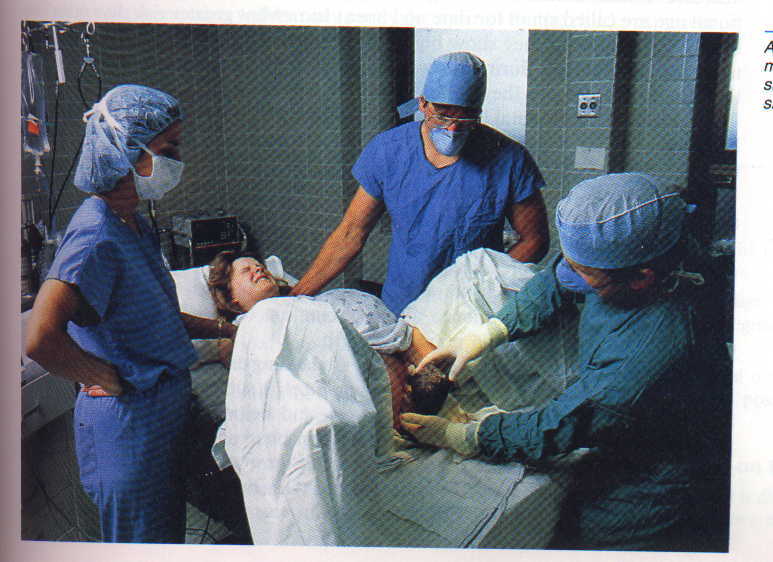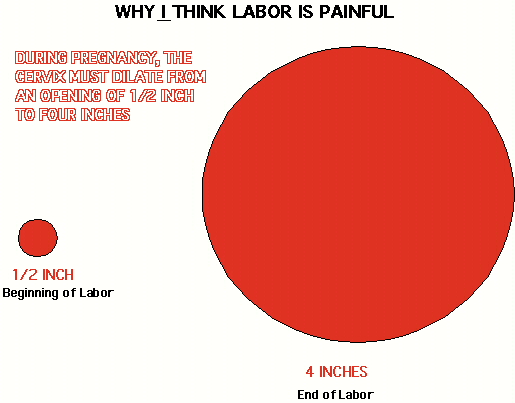 The Miracle
(?) of Birth
or
Making Something Natural
that was Natural All Along
One of the reasons I like this particular textbook is
that I find it is generally truthful. While many of the other human development
books seem to gloss over this point with medical discussions, the fact
is that CHILDBIRTH HURTS. It just seems to me somewhat remiss to cover
all of the stages of labor, Lamaze, LeBoyer and so on without mentioning
that painfully obvious fact. It annoys me when I read books and articles
by people like Dick-Read who, in my opinion, overemphasize the role of
tension and anxiety in producing pain during childbirth. The fact is, you
can talk about the miracle of birth and how emotionally self-satisfying
it is and all of that, but, having given birth to three children (which
is three more than any of the male physicians touting natural childbirth)
I remain unconvinced that childbirth itself is anything but a painful process
one must endure to have this wonderful baby at the end of it. That out
of the way (though I will have more to say later), let's cover a few of
the questions people often have about labor and delivery.
The Miracle
(?) of Birth
or
Making Something Natural
that was Natural All Along
One of the reasons I like this particular textbook is
that I find it is generally truthful. While many of the other human development
books seem to gloss over this point with medical discussions, the fact
is that CHILDBIRTH HURTS. It just seems to me somewhat remiss to cover
all of the stages of labor, Lamaze, LeBoyer and so on without mentioning
that painfully obvious fact. It annoys me when I read books and articles
by people like Dick-Read who, in my opinion, overemphasize the role of
tension and anxiety in producing pain during childbirth. The fact is, you
can talk about the miracle of birth and how emotionally self-satisfying
it is and all of that, but, having given birth to three children (which
is three more than any of the male physicians touting natural childbirth)
I remain unconvinced that childbirth itself is anything but a painful process
one must endure to have this wonderful baby at the end of it. That out
of the way (though I will have more to say later), let's cover a few of
the questions people often have about labor and delivery.
HOW DO I KNOW WHEN I AM IN LABOR?
As the eighth or ninth month approaches, pregnant
women, especially those who are pregnant for the first time, often wonder
how they will know when labor begins. The whole birth process seems to
have changed a great deal over the decades since the time my grandmother
gave birth to ten children at home (not all at once, of course, but over
a period of about fifteen years!) Today, we don't often have other women
around to say, "That's it, you're in labor." Women often go through pregnancy,
and at least the initial stage of labor, alone or with a partner who has
very little more experience than they do.
Signs labor is getting close include:
-
Lightening - this occurs when the baby turns head downwards and
drops slightly lower in the pelvis. You may hear women mention that the
baby has "dropped" or hear comments that a woman is 'carrying the baby
lower'. This usually occurs two or three weeks before labor - but not always.
So, if the baby has not dropped and the woman's due date is approaching
(or past) she should not necessarily conclude that, "Oh no, it is going
to be weeks before I have this baby! Lightening may not occur until
during labor.
-
Braxton-Hicks contractions (also known as false labor) - a contraction
is a tightening of your uterus. During labor, contractions move the baby
down the birth canal. There are other differences between real labor and
false labor, although the two are easily confused, especially by first
time mothers. (It is easy to panic if all of a sudden your whole stomach
seems to turn rock-hard and it hurts!). First, Braxton-Hicks contractions
usually quit if you change position or activity. If you are sitting up
working on the computer and go lay down, the contractions often stop. Dehydration
may be related to false labor. Drinking two or more glasses of water may
stop the contractions. With real labor, contractions don't stop no matter
what you do. Second, Braxton-Hicks contractions are irregular and do not
show a steady increase in frequency and strength. Contractions during real
labor will gradually come closer together and become stronger (more painful).
-
Mucus discharge - this is due to loss of the mucus plug, which is
at the opening to the cervix. This may occur a few days before labor.
-
Energy spurt - sometimes referred to as a 'nesting instinct', is
said to occur in some women a day or two before labor begins, accompanied
by an urge to clean up and get things in order. Personally, I have never
had an urge to clean up in my life, as everyone from my mother to every
cleaning lady I have ever employed can testify!
-
Breaking of the bag of waters - Throughout pregnancy, the baby is
well-cushioned, floating in a bag of amniotic fluid. In 10-15% of pregnancies,
before labor begins, the amniotic sac ruptures. If the break occurs low
in the sac, about a quart of fluid will gush out. If the break occurs higher
up, it will be a non-stop trickle of fluid, like a faucet that won't stop
dripping. About 80% of women go into labor within 24 hours after their
water breaks.
STAGES OF THE BIRTH PROCESS (WHEN YOU ARE REALLY IN LABOR)
1. Labor - the first and longest stage, lasting an average
of 14 hours in women having their first babies and about half that
for subsequent pregnancies. During labor, uterine contractions occur, which
become increasingly more frequent, longer in duration and more intense
(painful). I read a study recently (Morse, J.M. & Park,C. (1988). Differences
in cultural expectations of perceived painfulness in childbirth. In K.
L. Michaelson( Ed). Childbirth in America: Anthropological perspectives.
South Hadley, MA: Bergin & Garvey) which compared four groups of women
living in Canada; those of English descent, East Indians, Hutterites and
Ukrainians. The study reported that the first two groups viewed childbirth
as a medical problem, expected pain during childbirth and experienced the
most pain. The latter two groups, according to the authors, perceived childbirth
as being a natural part of life, and reported their birth experiences to
be the least painful. From the biological point of view (as opposed to
the anthropological one) labor is the time when dilation occcurs. Dilation
is the process whereby the opening to the cervix (the neck of the uterus)
dilates, that is, increases in diameter to allow the baby to pass through.
 The cervix dilates from the size on the left to the size on the right in
those eight or fourteen hours or however many it is, during the first stage
of the birth process, that is labor!
The cervix dilates from the size on the left to the size on the right in
those eight or fourteen hours or however many it is, during the first stage
of the birth process, that is labor!
2. The second stage of the birth process is referred to as delivery.
This is much shorter than the previous stage, on the average 90 minutes
for a first baby and 30-45 minutes for later births. This is also called
the expulsion stage. This second stage is when the baby passes through
the cervix and down the birth canal. Crowning, when the baby's head
can first be seen at the opening of the vagina, signals the beginning of
the delivery stage.

3. Afterbirth, the third stage of the birth process, is when
the placenta and other membranes are delivered. This generally occurs shortly
after the delivery of the infant and is the shortest of the three stages.
Now that you know it all, click here to take a quiz
on Chapter 3. Be sure you have finished reading the chapter first.
 The Miracle
(?) of Birth
The Miracle
(?) of Birth The Miracle
(?) of Birth
The Miracle
(?) of Birth
